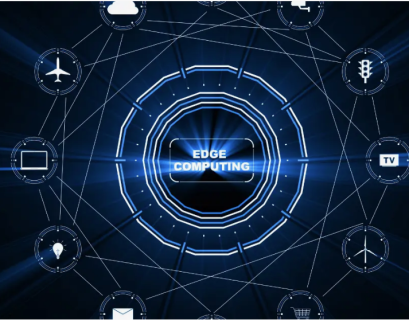Security is everything that defines a business’s success in the bigger picture. If your security is good, your operations will be smooth, complementing your overall IT infrastructure.
Unfortunately, with increasing cyber threats and a growing reliance on connected devices, businesses find challenges in protecting their crucial data.
One powerful solution that is gaining traction is edge solutions. These solutions play a key role in strengthening cybersecurity by bringing computing power closer to the data source.
Appreciating the growing role of edge solutions in cyber security, a report by Industry Arc mentions:
The Edge Security Market is projected to reach $106 billion by 2030, with a robust CAGR of 23.3% during the forecast period from 2023 to 2030.
Edge solutions offer a way to process data right where it is generated rather than relying on distant data centres.
But how exactly do edge solutions contribute to enhancing cybersecurity? Let’s dive into the topic and explore their significant role in securing the digital landscape.
Reducing Latency and Improving Response Time
One of the major benefits of edge solutions is the reduction in latency. Traditional cloud computing systems send data to a centralized server for processing. This process can take time, which can delay responses and leave systems vulnerable to attacks. By processing data closer to the source at the edge, edge solutions significantly reduce latency.
- Faster detection and response times
- Real-time security measures for critical data
- Minimizing delays in threat mitigation
This rapid processing at the edge ensures that cybersecurity threats are identified and dealt with almost immediately. As cyberattacks become more sophisticated, quick responses are crucial for minimizing damage and protecting sensitive information.
Decentralized Security Architecture
Edge solutions decentralize computing by distributing it across multiple devices rather than relying on a single centralized system. This decentralization creates a more resilient network, making it harder for hackers to target a single point of failure.
For instance,
If one node or device at the edge is compromised, the rest of the system can continue functioning normally, ensuring that a breach does not cripple the entire network.
In contrast to traditional centralized models, this distributed approach improves the overall security of a network. It creates multiple layers of defense, which increases the chances of preventing cyberattacks.
- Protection through multiple layers of defense
- Less reliance on centralized data centers
- Reduced risks from a single point of failure
The increased complexity of edge solutions makes it more difficult for attackers to penetrate the system, thus strengthening the security framework.
Enhanced Data Privacy and Compliance
Data privacy regulations like GDPR and CCPA are pushing organizations to rethink how they store and handle sensitive information. Edge solutions offer a way to comply with these regulations by processing data locally rather than sending it to distant servers. This approach allows businesses to keep personal data closer to its source, improving privacy and making it easier to meet compliance standards.
With edge computing, organizations can ensure that sensitive data does not leave their premises or local region, reducing the risks associated with data transfers and cross-border data regulations.
- Local data processing for enhanced privacy
- Simplified compliance with data protection laws
- Reduced risk of data breaches and leaks
As privacy concerns grow among consumers, businesses adopting edge solutions can demonstrate their commitment to safeguarding personal information, and building trust with customers.
Real-Time Threat Detection and Prevention
Edge solutions are vital in the fight against cyber threats because they enable real-time threat detection. By processing data directly at the source, edge solutions can quickly analyze network traffic and identify any unusual behavior or potential threats. This immediate threat detection ensures that businesses can react faster, preventing or minimizing damage before it spreads.
- Proactive identification of threats at the edge
- Minimizing damage with immediate mitigation actions
- Detection of anomalies in real-time data flow
Edge solutions can also use machine learning and artificial intelligence to enhance the accuracy of threat detection, making them even more effective in identifying complex or previously unknown threats.
Reducing the Attack Surface
With many connected devices in the modern business environment, each one can serve as a potential entry point for hackers. Edge solutions help reduce the attack surface by ensuring that not all data needs to be transmitted to centralized cloud servers. By processing sensitive data locally, only the essential information needs to be shared, thus limiting the number of access points hackers can target.
Moreover, by securing data directly at the edge, businesses can ensure that even if one device is compromised, the damage is contained within that device, reducing the overall impact on the network.
- Fewer data transmissions reduce access points for attacks
- Enhanced security at every device level
- Minimized exposure to cyber threats
By reducing the attack surface, edge solutions provide an added layer of protection that is vital in today’s connected world.
Strengthening Authentication and Access Control
As businesses adopt edge solutions, robust authentication and access control measures become even more critical. Edge solutions support the use of advanced authentication techniques such as biometrics, multi-factor authentication (MFA), and identity-based security policies. These techniques can be applied directly at the edge to ensure that only authorized users can access sensitive data or systems.
By embedding strong security measures at the edge, businesses can better control who is accessing their resources, thus reducing the risk of unauthorized access.
- Secure access through multi-factor authentication
- Biometric authentication at the edge for stronger control
- Restricting access based on user roles and locations
These access control features are crucial in preventing unauthorized access and ensuring that sensitive data remains protected.
Cost-Effectiveness and Scalability
While enhancing cybersecurity, edge solutions are also cost-effective. By reducing the need for centralized data centers and minimizing data transmission costs, edge solutions can save businesses money. Additionally, they offer scalability, allowing organizations to expand their network as needed without significant infrastructure investments.
- Lower operational costs by reducing reliance on cloud servers
- Easy to scale as the business grows
- Reduced data transfer and storage expenses
The cost savings and scalability make edge solutions an attractive option for businesses looking to enhance cybersecurity without breaking the bank.
Future-Proofing Cybersecurity
The digital landscape is constantly changing, with new cybersecurity threats emerging every day. Edge solutions are future-proof because they are adaptable to new technologies and evolving security challenges.
As businesses continue to adopt IoT devices, 5G networks, and other innovative technologies, edge solutions can evolve to meet the growing demands of securing these new systems.
- Flexibility to adapt to future technological advancements
- Strong security measures for next-gen networks and devices
- Preparedness for emerging cybersecurity challenges
Conclusion: The Vital Role of Edge Solutions in Cybersecurity
As we’ve explored, edge solutions play a vital role in enhancing cybersecurity by providing real-time data processing, reducing latency, decentralizing security, improving data privacy, and reducing the attack surface. They offer businesses a scalable, cost-effective, and resilient approach to securing their digital infrastructure.










